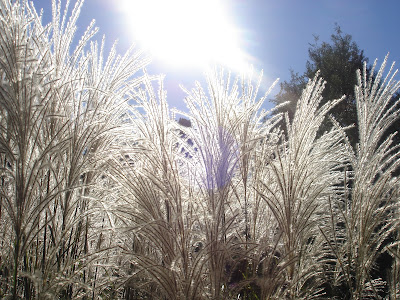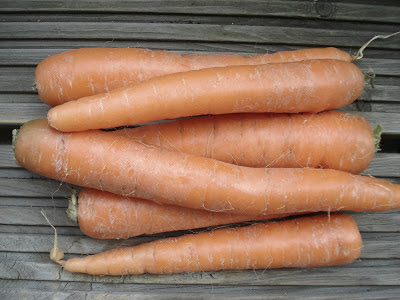Sunny October
I can't believe it's October already... Where has the time gone by? I must have been in a true funk not to notice that autumn had truly settled in. I saw the geese fly overhead several times already, I registered the fall colours, yet it only hit me this morning that summer was well and truly over...
October may appear to be the dying season, what with the plants and animals readying themselves for the unforgiving winter, but there is still much to be gleaned from fields and orchards. Gung-ho gardeners may well stretch out the growing season by growing fall crops, but I'm still harvesting my summer garden, as it is still not quite ready to give up just yet: my tomatoes are still producing a few pounds a day, and who am I to tell them it is time to stop?
What to look for this month:
Autumn Strawberries
When I was a child, strawberries in October were unheard of. Even those plastic berries from Florida and California were a rarity back then... But autumn strawberries are now a reality, and they are not a fruit to be sniffed at. They are a little more pricey than summer berries, since fall varieties are a little less productive than their summer counterparts, but they are our last link to summer, so if you are craving strawberries, they are well worth the expense. They will be around for a week or two more, if the warm days stick around.
Apples, Pears
Apples and pears have already made an appearance a few weeks back, but doesn't October feel like their true month? I, personally, am not a fan of summer apples, I find them too soft for my taste, so I feel positively spoiled when the Russets, Empires and Spartans make their appearance on market shelves. Latter season Cortlands also seem to be more interesting than late-summer fares: the cold night air seems to crisp them up, and brings out more tartness. Supermarkets are also jumping on the local produce bandwagon, so you will be noticing a bigger variety, however, you should still be vigilant: my local store had 10 different varieties on offer, only three of which were actually grown in Canada. For a real smörgåsbord of choice, there is nothing like the farmers' market; that's where you will find old school varieties like Russets and crab apples. If you prefer your apples in the crisp or crunchy spectrum, keep them in a cool place - in fact, if you've already turn the heater in your home, keep your apples in the refrigerator.
Pears are a more borderline orchard fruit in Quebec, our winters being a little too harsh for most varieties. However, there are a few brave souls who still insist on growing pears. Belle d'Anjou, Bosc and Bartlett are the most common pear varieties grown in Eastern Canada, and they will be available for a few more weeks. Ripe pears are very fragile, so they are always picked under-ripe. Unlike many other fruits though, pears will continue to ripen and sweeten once picked, all you need to do is keep them out of the fridge until they have softened sufficiently. If you are in a hurry to eat a ripe pear, place them in a closed paper bag with an apple or a banana.
Both pears and apples are ideal for autumn desserts (such as this luscious cake I wrote about previously, either fruit can be used in the recipe), but they are also lovely paired with savoury dishes: try roasted pears and apples with a pork or duck roast... I'll bet you can even add pizazz to a humdrum turkey dinner with a nice apple and pear sauce. Or how about adding a few quartered fruits to the pan of roasting root veggies... I think I know what I'm making for dinner tonight!
Both pears and apples are ideal for autumn desserts (such as this luscious cake I wrote about previously, either fruit can be used in the recipe), but they are also lovely paired with savoury dishes: try roasted pears and apples with a pork or duck roast... I'll bet you can even add pizazz to a humdrum turkey dinner with a nice apple and pear sauce. Or how about adding a few quartered fruits to the pan of roasting root veggies... I think I know what I'm making for dinner tonight!
Root Vegetable
Carrots, beetroot, parsnips, celeriac, rutabaga, turnips, potatoes, yams... the list goes on. Root vegetables are the quintessential autumn/winter food: they are nature's way of storing nutrients over the long cold months -mainly for the plants' use, but humans and other animals have learnt to appreciate their value during the season of little growth. Though they can be stored in the refrigerator, most root vegetables prefer being kept in a cool, dark place, like an unheated cupboard, preferably in the company of other roots vegetables.
Winter Squashes
The winter squashes have already hit the stands, even the pumpkins are making an early appearance this year. Just in time to test a few vegetarian recipes before Thanksgiving Day in Canada... Why settle for pumpkin pie, when you can have a squash and ricotta tart? I think I'm going to play around with this one...
The winter squashes have already hit the stands, even the pumpkins are making an early appearance this year. Just in time to test a few vegetarian recipes before Thanksgiving Day in Canada... Why settle for pumpkin pie, when you can have a squash and ricotta tart? I think I'm going to play around with this one...
Salad Greens
Lettuce, roquette and other salad ingredients are usually available year-round, but these plants actually prefer cool growing conditions, so are most abundant in the spring/early summer and in the fall. They often taste differently from those available at the height of summer, with fewer notes of bitterness, a tad more sweetness for some, and definitely more crunch.
Cabbage, Kale, and Family
Artichokes are one of my favourite vegetables. They do not readily grow in our climate, but they can be coaxed to produce even in Quebec with a little care. Although artichokes are really a spring crop in most climes (they are flower buds after all), they are an autumn produce in most of Canada.
There are few commercial fig growers in Canada, though I've heard that there are a couple of them in British Colombia... Oh, do I envy those of you who live over there. Figs do grow in Quebec -the ones above were spotted at the Montreal Botanical Garden- but require a lot of hands on care, as they are not hardy in our climate, so they are not grown commercially this side of Canada. Now is the season for figs in the Northern Hemisphere, and if you are lucky enough to know someone with a fig tree, now is the time to ply the said person with a few treats in exchange for a jewel of a fruit.
If you do get your hands on a few, try roasting them in a pan with a drizzle of honey. When the figs begin to crisp up at the edges, remove to a plate and serve with a spoonful of soft goat's cheese... By the way, it is almost the end of goat cheese season: large dairies and a handful of goat herders do manage to produce cheeses all year long (from frozen milk), but if you are fond of raw milk goat cheese, you will have to hoard them while you can, because goats do not produce milk in during the winter months.
Cabbages and Family
Round cabbage; Savoy cabbage; pointed cabbage; Brussel sprouts; kales of all shapes and colours; broccoli; kohlrabi; bok choi.... The season might not be calling for coleslaws and other salads, but 'tis definitely the season for sauerkraut, stuffed cabbage, braised sprouts, and why not a slaw with fall flavours?
Austrians prepare a warm slaw by thinly slicing cabbage over which is poured hot cider vinegar, thin slivers of crisp bacon and caraway seeds. The vinegar does not cook the cabbage, merely wilting it. Served warm, it is apparently rather delightful with braised pork shoulder... A vegetarian version can easily be made by omitting the bacon, substituting it with melted butter or some oil, and adding a pinch of cumin seeds. Serve it with a veggie pot pie or crispy roasted vegetables, and who needs roasted pig anyway?
I'm probably forgetting a whole slew of autumn treats, but I will be keeping an eye out for them! If you haven't yet stocked up on tomatoes and other summer vegetables for the winter, run, do not walk to the farmers' market: the bushels of tomatoes, peppers and what nots will not be around for much longer.
Bon app'!
If you do get your hands on a few, try roasting them in a pan with a drizzle of honey. When the figs begin to crisp up at the edges, remove to a plate and serve with a spoonful of soft goat's cheese... By the way, it is almost the end of goat cheese season: large dairies and a handful of goat herders do manage to produce cheeses all year long (from frozen milk), but if you are fond of raw milk goat cheese, you will have to hoard them while you can, because goats do not produce milk in during the winter months.
Cabbages and Family
Round cabbage; Savoy cabbage; pointed cabbage; Brussel sprouts; kales of all shapes and colours; broccoli; kohlrabi; bok choi.... The season might not be calling for coleslaws and other salads, but 'tis definitely the season for sauerkraut, stuffed cabbage, braised sprouts, and why not a slaw with fall flavours?
Austrians prepare a warm slaw by thinly slicing cabbage over which is poured hot cider vinegar, thin slivers of crisp bacon and caraway seeds. The vinegar does not cook the cabbage, merely wilting it. Served warm, it is apparently rather delightful with braised pork shoulder... A vegetarian version can easily be made by omitting the bacon, substituting it with melted butter or some oil, and adding a pinch of cumin seeds. Serve it with a veggie pot pie or crispy roasted vegetables, and who needs roasted pig anyway?
I'm probably forgetting a whole slew of autumn treats, but I will be keeping an eye out for them! If you haven't yet stocked up on tomatoes and other summer vegetables for the winter, run, do not walk to the farmers' market: the bushels of tomatoes, peppers and what nots will not be around for much longer.
Bon app'!








Very nice blog!
ReplyDeleteelenasc.wordpress.com
Thank you!
ReplyDelete